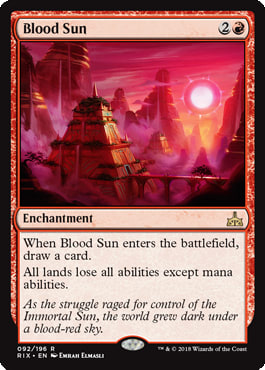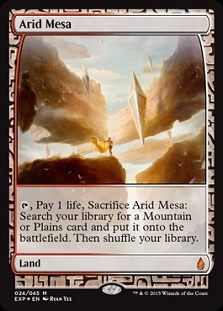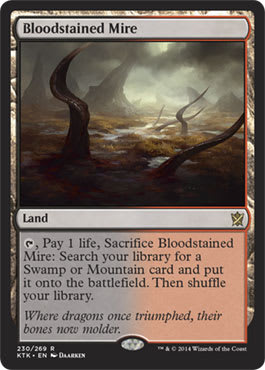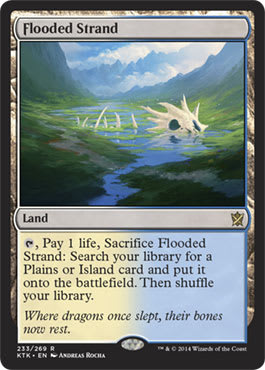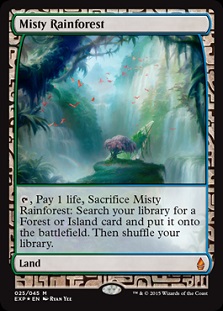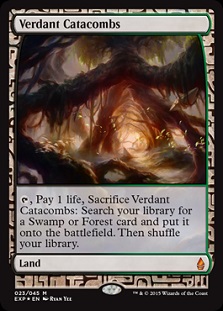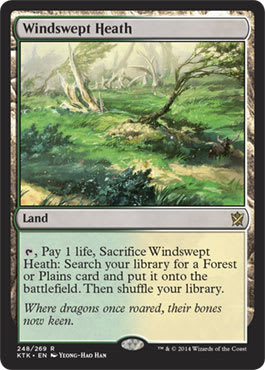--Buddha
The Truth About Blood Sun
The truth is, Blood Sun looks to be the most influential card printed in years. Years!
It may not be intuitive because most players default to "Standard" when they think about the impact of new cards . . . But Blood Sun's impact (barring some currently unanticipated reprints) will be in wider formats, primarily Modern.
Sound crazy?
So what's the deal with Blood Sun anyway?
Blood Sun costs the same as some other mana disruption cards, like Stone Rain and Blood Moon, at ![]()
![]() .
.
It has the most magical of add-on abilities, "draw a card" in its first line of text . . .
And the initially innocuous second line:
"All lands lose all abilities except mana abilities."
Do you know what lands have non-mana abilities?
Can I get a "what what"?
If you play Blood Sun quickly enough, it is like a Stone Rain for all the fetchlands in the opponent's deck.
Oh, and it draws a card.
Blood Sun Play Patterns
Blood Sun is increasingly valuable the faster you play it.
The reason for that is if you get Blood Sun down after the opponent plays and / or breaks their fetchland, it is just a three mana cantrip. However, if you play it super quickly, it can thoroughly manascrew the opponent.
For example, imagine you are playing a Burn deck (pretty common deck in Modern, right?). The typical Burn deck has something like:
- 3-4 Inspiring Vantage
- 4-5 fetch-able lands
- 11-12 Fetchlands
It is not uncommon for a Burn player to keep a 2 or 3 land hand; by basic proportion, the expectation would be that two if not all three lands will be fetches.
That's not the only bad thing.
Imagine your ~1 non-fetch starting land is an Inspiring Vantage. You will almost certainly play it first, right? Unless you have some really unusual hand that has no first turn play, you will run out the Vantage first because it is awesome on turn one (or rather, turns 1-3) and kind of bad later. Conversely, the fetches retain a lot of value later because of cards like Searing Blaze.
So you will voluntarily hold onto your fetches early.
Now imagine you are on the draw and the opponent plays a first turn Birds of Paradise . . .
Consider the ![]()
![]() Land Destruction deck George Baboussis played to Top 8 at the same Modern Regionals Championship I recently navigated with Chained to the Rocks:
Land Destruction deck George Baboussis played to Top 8 at the same Modern Regionals Championship I recently navigated with Chained to the Rocks:
R/G Land Destruction -- Modern| George Baboussis
- Creatures (16)
- 1 Birds of Paradise
- 2 Huntmaster of the Fells
- 2 Inferno Titan
- 3 Thragtusk
- 4 Arbor Elf
- 4 Tireless Tracker
- Planeswalkers (3)
- 3 Chandra, Torch of Defiance
- Sorceries (11)
- 1 Primal Command
- 3 Bonfire of the Damned
- 3 Mwonvuli Acid-Moss
- 4 Stone Rain
- Enchantments (8)
- 4 Blood Moon
- 4 Utopia Sprawl
- Lands (22)
- 1 Mountain
- 9 Forest
- 1 Kessig Wolf Run
- 3 Stomping Ground
- 4 Windswept Heath
- 4 Wooded Foothills
- Sideboard (15)
- 2 Natural State
- 3 Scavenging Ooze
- 1 Thrun, the Last Troll
- 1 Creeping Corrosion
- 3 Kitchen Finks
- 2 Ancient Grudge
- 3 Lightning Bolt
This deck, with nine first turn accelerators, is a great shell for Blood Sun.
I don't know that you can sub Blood Sun one-for-one for either Blood Moon or Stone Rain, but the possibilities are compelling.
What if we just try something like this:
R/G Land Destruction -- Modern | Mike Flores
- Creatures (16)
- 1 Birds of Paradise
- 2 Huntmaster of the Fells
- 2 Inferno Titan
- 3 Thragtusk
- 4 Elvish Mystic
- 4 Tireless Tracker
- Planeswalkers (3)
- 3 Chandra, Torch of Defiance
- Sorceries (9)
- 1 Primal Command
- 2 Bonfire of the Damned
- 2 Mwonvuli Acid-Moss
- 4 Stone Rain
- Enchantments (10)
- 2 Blood Moon
- 4 Blood Sun
- 4 Utopia Sprawl
- Lands (22)
- 1 Mountain
- 9 Forest
- 4 Copperline Gorge
- 4 Rootbound Crag
- 4 Stomping Ground
- Sideboard (15)
- 1 Blood Moon
- 3 Kitchen Finks
- 2 Scavenging Ooze
- 1 Thrun, the Last Troll
- 4 Lightning Bolt
- 4 Ancient Grudge
The ability to land a lightning-quick Blood Sun can create an amazingly lopsided game. What if you were the Burn deck we were talking about and before you played a second land, Blood Sun were in play? What is the likelihood you can beat a deck with Kitchen Finks, Huntmaster of the Fells, and Thragtusk . . . with one land?
Changing Values Under Blood Sun
Now the shift to George's deck (above) is a light, not-particularly-frothy, brew.
But it does more than just add Blood Sun to the main deck.
Check out the mana.
George's baseline included eight fetches and four copies of Arbor Elf. If we are going to play Blood Sun, we have to blunt our own use of fetches. At the same time, Arbor Elf needs to make way for the slightly less flexible Elvish Mystic . . . What if we have Copperline Gorge as our first land? Right?
The reason for all this is that land values change dramatically in a format with Blood Sun.
Think for a second what the relative values of all these cards is:
I think this is about the generally-thought order.
Wooded Foothills is the most flexible, generally, at every stage. It's only worse than a Copperline Gorge on turns 1-3; dramatically better every turn after. It encompasses all the value of a Stomping Ground and more, for the price of one life point. Barely anyone will play a Rootbound Crag at all.
These values go crazy in a world with Blood Sun.
Copperline Gorge (or Inspiring Vantage, or whatever) already contends . . . It / they / etc. skyrocket in the Blood Sun world. Already better turns 1-3, even a Copperline Gorge that enters the battlefield tapped is better than a Wooded Foothills that will never break.
Stomping Ground gets substantially better, too. I mean, we even went from three to four!
The reason is that while Blood Sun crushes Wooded Foothills, it has a positive impact on Stomping Ground. In fact both Stomping Ground and Copperline Gorge improve in Blood Sun's world, both practically and relatively against best-of-breed Wooded Foothills.
I'm not super sold on the Rootbound Crags -- even the ones I added to the sample deck list myself -- but again, they actually tap for mana.
Separately Blood Sun takes a huge edge off of cards like Searing Blaze. All those games you used to win with careful land sequencing? Searing Blaze is merely a sorcery under Blood Sun.
Blood Sun and Blood Moon
One of the first places I wanted to try were Mono-Red or Blue Moon shells that played 3+ copies of Blood Moon.
After just a little brewing, I determined you can't rely on Blood Sun in the way decks like Skred Red or Blue Moon use The Dark's original.
The difference is that Blood Moon is in a sense equally good as long as you play it sometime before you lose. Remember the old "broken" Blue Moon draw? A Lightning Bolt, a Mana Leak, and a Blood Moon could beat most decks from only six cards, when that deck debuted.
Blood Sun can be nigh unbeatable if you run it early enough . . . But stranding someone on 2-3 actually mana-producing lands is not the same as a kill. Third turn Moon, on the other hand, will sometimes be a Mind Twist.
Blood Moon nerfs Tron. Blood Sun does almost nothing there; might in fact become Tron's sidekick against Ghost Quarter.
On balance, I once won a match on two Eidolons cast off fetches with Blood Moon in play, after being Annihilated down to nil by Emrakul. Blood Sun would have been the closeout.
Point being: The two cards represent some overlap / redundancy but are not interchangeable.
Certainly they can be played together. For example:
Mono-Red Sneak Attack -- Legacy | utdzac
- Creatures (15)
- 1 Combustible Gearhulk
- 2 Emrakul, the Aeons Torn
- 2 Worldspine Wurm
- 3 Griselbrand
- 3 Inferno Titan
- 4 Simian Spirit Guide
- Instants (7)
- 3 Seething Song
- 4 Through the Breach
- Enchantments (11)
- 3 Blood Sun
- 4 Blood Moon
- 4 Sneak Attack
- Artifacts (8)
- 4 Chalice of the Void
- 4 Lotus Petal
- Lands (19)
- 10 Mountain
- 1 Crystal Vein
- 4 Ancient Tomb
- 4 City of Traitors
- Sideboard (15)
- 1 Abrade
- 1 Boil
- 1 Chandra, Torch of Defiance
- 2 Faerie Macabre
- 2 Fiery Confluence
- 2 Kozilek's Return
- 2 Magus of the Moon
- 1 Sorcerous Spyglass
- 3 Trinisphere
Zac Elsik's deck from the recent Team Open is actually a Legacy deck! Not even Modern . . .
It does show off how we might see Blood Sun not only play with Blood Moon, but how it's supposed land hosing ability can actually work with limitations like the one on City of Traitors. Remember what we said about Stomping Ground getting better with Blood Sun? City of Traitors makes off even better!
Blood Sun and the Top Decks in Modern
Blood Sun is powerful in the abstract, says "draw a card" on it, and can produce advantages where there were supposed to be limitations. But how does it interact with the top decks, specifically?
- Jeskai Control -- Not a lot here; yes, there are about eight fetches to be hosed, plus Celestial Colonnade, but nothing earth-shattering
- Affinity -- Nexus and Nexus! While Blood Sun doesn't slow this deck down, it can cut off much of Affinity's end game.
- Grixis Death's Shadow -- This archetype typically has about twelve fetchlands. Blood Sun can mess it up like Burn; even worse, Death Shadow's game plan typically involves pulsing life total with its lands . . . Blood Sun can in fact keep Death's Shadow small.
- The Rock -- Hissing Quagmire, Field of Ruin

 Control -- Everything about Jeskai Control; and Field of Ruin; and Ghost Quarter, too
Control -- Everything about Jeskai Control; and Field of Ruin; and Ghost Quarter, too- Titan Shift -- Boom! This archetype is the big payoff. Blood Sun turns Valakut off.
Most of the rest of the decks in the format have less vulnerability, but still some vulnerability.
Blood Sun has an immense ceiling. Is ![]()
![]() the right place to break it? It certainly seems like a solid place to try.
the right place to break it? It certainly seems like a solid place to try.
LOVE
MIKE














